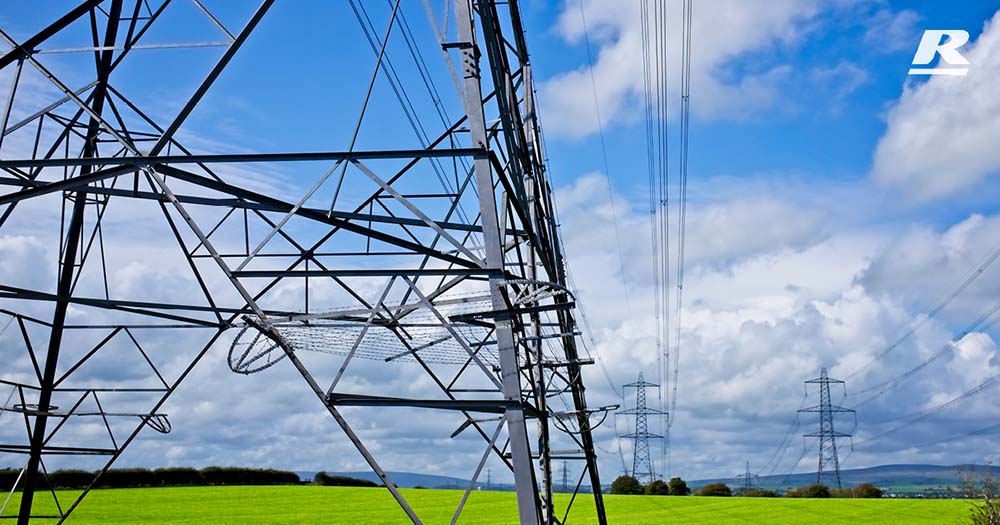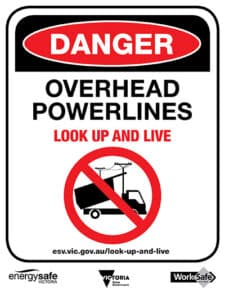Managing the risks of overhead powerlines
Farm equipment is getting bigger, but powerlines are not getting higher! Operating large vehicles and other mobile plants near overhead powerlines, even without direct contact, poses many serious workplace health and safety risks, including electrocution, electric shock and burns.
Each year, serious injuries or fatalities occur in Victoria because of farming equipment and machinery hitting powerlines. You, as the farmer, manager and/or landowner are responsible for the safety of others entering your property.
In this article we recommend some ways for you to control risks on farm and when receiving deliveries as well as provide a checklist for you to use.
When working on farm 
Farmers should ensure that:
- Employees (including casuals and independent contractors) are aware of the location of the powerlines and are provided with sufficient information, instruction and training
- Items are stored, loaded and unloaded a safe distance from overhead powerlines of any height, unless there is a physical barrier such as a shed or fence to prevent vehicles coming into contact with powerlines.
- Hay, wooden posts, or old metal equipment are not stored near powerlines.
- Entrance gates have clear signage, indicating that there are overhead powerlines located on the property. (Two signs are available free of charge from Energy Safe Victoria.
If any work close to a power line is planned, a team meeting must be held before starting work to:
- Discuss the dangers
- Remind employees where the powerlines are located
- Remind employees not to use machinery with reach near powerlines, such as telehandlers, front end loaders, cherry pickers, and tip trucks
- Remind employees to ensure that their line of travel is always away from the direction of powerlines.
If your designated delivery zone is near the entrance to your property:
- Ensure that any nearby paddocks with overhead powerlines within them are padlocked, with clear signage, to avoid delivery drivers accessing them independently.
- Have the power supply company put tags onto your electricity lines to make them more visible.
When receiving deliveries
- Encourage drivers to ask if there are overhead powerlines on the property and where they are located, before they enter the property.
- Make sure that a designated delivery zone/s are set up, in a safe location, away from powerlines and clearly marked. Some examples include:
- marking a designated delivery area or pathway that is well away from powerlines with the distance clearly marked
- placing a physical barrier (eg fence or shed) between the delivery site and powerlines.
- Provide clear instructions to the delivery driver about where safe delivery zones and powerlines are located. This should be done when placing an order and when receiving a delivery.
- Advise the driver to get out of the vehicle and assess the delivery site prior to making a delivery every time – look for overhead powerlines (sometimes they are difficult to see) and poles which may indicate the presence of powerlines.
- When delivering in open areas like farms, instruct drivers not to commence delivery near overhead powerlines of any height. If this is not possible, ensure the direction of travel when unloading is away from the powerlines.
- Only ever request deliveries to be unloaded into a designated safe delivery zone.
Remember, you don’t have to make contact with a powerline for it to be fatal. Electricity can jump if equipment or machinery get too close.
Farm safety checklist
Use this checklist to ensure you’re doing what’s required for all to stay safe around powerlines.
Have you… Yes or N/A
- Created a detailed and accurate site plan highlighting all powerlines, travel routes, safe work areas and hazards.
- Set up loading and unloading zones for any truck pick-ups or deliveries in a location well away from powerlines.
- Spoken to your power company for advice on safely working near powerlines, if required.
- Installed barriers or fences or signs to prevent high machinery from getting too close to powerlines.
- Installed warning signs at farm entry points or travel routes where powerlines run overhead. Installed warning signs along the route of known underground powerlines.
- Created a safety induction pack for any new workers or other people coming onto the farm to work.
- Educated all farm workers about the risk of overhead and underground powerlines, and the requirements of the No Go Zones.
- Kept records of inductions and training on electrical safety.
- Made an emergency plan for managing electrical incidents, which includes details about what action to take if contact is made with a powerline.
- Included emergency contact details of power companies in your farm emergency plan. Attach No Go Zone stickers to all tall machinery and equipment.
- Saved power pole locations with exclusion zones onto farm GPS systems.
- Marked heights on your machinery near the operating controls.
Sources: Energy Safe Victoria, WorkSafe Victoria
If you’d like to increase your livestock farming gains and get professional feeding advice. Call 1300 REID FEED or enquire here >

